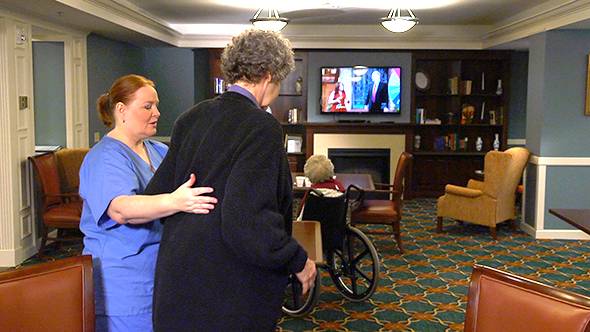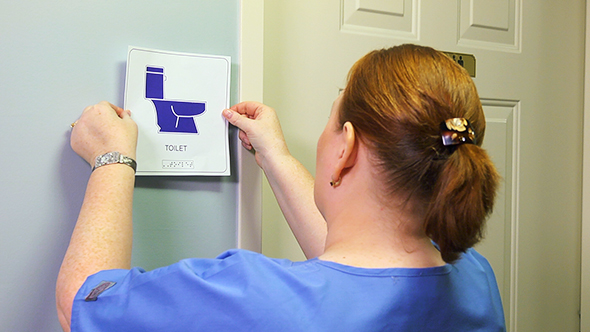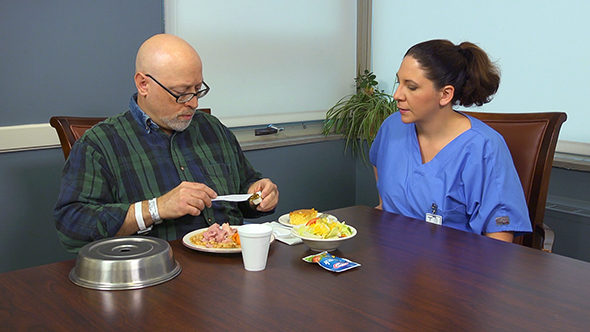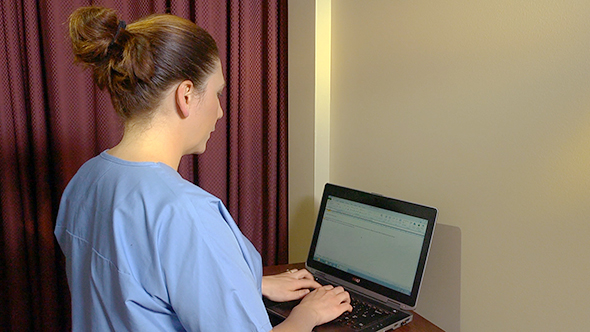Confusion and Dementia
Select a Skill:
- » Caring for the Person with Confusion and Dementia
- » Caring for the Person with AD and Other Dementias
Take the Review Test:

Purpose

- Alzheimer’s disease (AD) is a brain disease. Many nerve cells that control intellectual and social function are damaged and die. These functions include memory, thinking, reasoning, judgment, language, behavior, mood, and personality.
- The person has problems with work, everyday functions, and family and social relationships. There is a slow, steady decline in memory and mental function.
- The classic sign of AD is gradual loss of short-term memory. Signs and symptoms become more severe as the disease progresses. The disease ends in death.
- AD is often described in terms of three stages—mild, moderate, and severe. The Alzheimer’s Association describes seven stages:
- Stage 1—No impairment
- Stage 2—Very mild cognitive decline
- Stage 3—Mild cognitive decline
- Stage 4—Moderate cognitive decline (mild or early stage)
- Stage 5—Moderately severe cognitive decline (moderate or mid-stage)
- Stage 6—Severe cognitive decline (moderately severe or mid-stage)
- Stage 7—Very severe cognitive decline (severe or late stage)
- AD changes how a person behaves or acts. These changes are common:
- Getting upset, worried, or angry more easily
- Acting depressed
- Losing interest in things
- Believing other people are hiding things
- Pacing a lot of the time
- Wandering
- Sundowning (increased signs and symptoms of AD during hours of darkness)
- Hallucinations (seeing, hearing, smelling, or feeling something that is not real)
- Delusions (false beliefs)
- Paranoia (delusions or suspicions about a person or situation)
- Catastrophic reactions (extreme responses to minor issues)
- Agitation and restlessness
- Aggression and combativeness
- Problems with intimacy and sexuality
- Repetitive behaviors (actions repeated over and over)
- Communication problems
- Screaming
- Rummaging and hiding things
- Usually, the person is cared for at home until symptoms are severe. Adult day care may help. Often assisted living or nursing center care is required.
Equipment
Roll cursor over items to see labels. For the purposes of clearly depicting the equipment, a barrier is not shown in this photo. When providing care, a barrier should always be placed on the surface before placing the equipment.

Bathroom picture sign
Dining room picture sign
Outlet plug
Outlet safety plate
Sliding lock at top of door
Medicine bottles with childproof caps
Safety covers for knobs on stoves
Identification bracelet
Easy to put on clothing options
Large calendar
Clock with large numbers
Plastic cup with lid
Plastic eating utensils
Eyeglasses
Hearing aids
Standard nightlight
Sensor nightlight
Radio/CD player
Delegation
- Follow delegation guidelines. Before caring for the person with AD and other dementias, obtain this information from the nurse and care plan:
- How much assistance the person needs with safety, hygiene, nutrition and fluids, elimination, activity, comfort, and sleep
- Specific types of care noted in the care plan
- What observations to report and record
- When to report observations
- What patient or resident concerns to report at once
Preparation

- Observe quality-of-life measures.
- Review the information under Delegation and Safety and Comfort.
- Practice hand hygiene.
- Collect the equipment.
- Identify the person. Check the ID bracelet against the assignment sheet. Calling the person by name is not the best practice for identification. A person with confusion or dementia may answer to any name called.
- Adjust the environment appropriately.
- Follow set routines.
- Avoid changing rooms or roommates.
- Place picture signs by room doors, bathrooms, dining rooms, and other areas.
- Keep personal items where the person can see them.
- Stay within the person’s sight to the extent possible.
- Place memory aids (large clocks and calendars) where the person can see them.
- Keep noise levels low.
- Play music and show movies from the person’s past.
- Select tasks and activities that fit the person’s abilities and interests.
Safety

- Some behaviors and problems are not caused by AD. They may be caused by an illness, injury, or drug. If the cause is not treated, it may threaten the person’s life. Always report behavior changes to the nurse.
- Because judgment is poor, persons with AD cannot tell what is safe or dangerous. Life-threatening accidents are great risks. They can walk into traffic or a nearby river. If not properly dressed, heat or cold exposure is a risk.
- The person’s behaviors may not mean paranoia. Fears of harm, strangers, stealing, mistreatment, and so on may be real. Some people take advantage of vulnerable adults. This includes sexual abuse and financial abuse. You must protect the person from harm, abuse, and mistreatment.
- Reassure the person that you are there to help.
- Remove harmful, sharp, and breakable items from the area.
- Provide plastic eating and drinking utensils.
- Place safety plugs in electrical outlets. Or cover outlets with safety plates.
- Keep cords and electrical items out of reach. Or unplug them when not in use.
- Remove electric appliances, such as hair dryers, from the bathroom.
- Store personal care items, such as shampoo and lotion, in a safe place.
- Keep childproof caps on drug containers and household cleaners.
- Store household cleaners and drugs in locked storage areas.
- Store dangerous equipment and tools in a safe place.
- Remove knobs from stoves or place safety covers on the knobs.
- Remove dangerous appliances, power tools, and firearms from the home.
- Store car keys in a safe place.
- Supervise the person who smokes. Store cigarettes, matches, and other smoking materials in a safe place.
- Practice safety measures to prevent falls, fires, burns, and poisoning.
- Lock all doors to kitchens, utility rooms, and housekeeping closets.
Comfort
- Follow the person’s routine. Meals, bathing, exercise, TV, bedtime, and other activities have a schedule. This promotes a sense of order and what to expect.
- Consult the nurse before making any changes to the environment. Such changes can cause confusion for the person with dementia.
Procedure Video
Audio Description: OFFFollow-up Care

- Provide for comfort.
- Place the call light within reach.
- Raise or lower bed rails. Follow the care plan.
- Complete a safety check of the room.
- Practice hand hygiene.
Reporting/Recording
- Report and record your observations, including:
- Signs and symptoms of health problems, such as illness, infection, drugs, lack of sleep, pain, fever, skin alterations, constipation, hunger, thirst, poor vision or hearing, alcohol, and caffeine.
- Any other changes in the person’s condition.
Review Questions
Select the best answer.
1. What is the classic sign of Alzheimer’s disease (AD)?
 Catastrophic reactions
Catastrophic reactions Agitation and restlessness
Agitation and restlessness Loss of short-term memory
Loss of short-term memory Rummaging and hiding things
Rummaging and hiding things
Select the best answer.
2. A person with Alzheimer’s disease (AD) tells you that the cook put rat poison in her food. Which behavior is this person displaying?
Select the best answer.
3. In a person with Alzheimer’s disease (AD), which behavior suggests sundowning?
 Pacing a lot of the time
Pacing a lot of the time Losing interest in things
Losing interest in things Worsening of symptoms at night
Worsening of symptoms at night Believing that people are hiding things
Believing that people are hiding things
Select the best answer.
4. Which action is helpful for a person with Alzheimer’s disease (AD) who often wanders?
 Limit exercise for the person.
Limit exercise for the person. Let the person wander in enclosed areas.
Let the person wander in enclosed areas. Apply restraints because wandering is dangerous.
Apply restraints because wandering is dangerous. Reduce the person’s activities to avoid overstimulation.
Reduce the person’s activities to avoid overstimulation.
Select the best answer.
5. Which action is helpful for a person with Alzheimer’s disease (AD) who has hallucinations or delusions?
 Try to talk him or her out of the false belief.
Try to talk him or her out of the false belief. Give the person a butter knife for “protection.”
Give the person a butter knife for “protection.” Limit activities because they add to confusion.
Limit activities because they add to confusion. Turn off any violent or disturbing programs on TV.
Turn off any violent or disturbing programs on TV.
You have completed the Review Questions for this skill. To take the Review again select the Start Over button. To proceed to another skill select from the dropdown menu. Select the Home or Back button to proceed to the next section.

